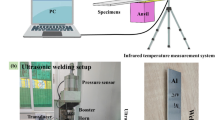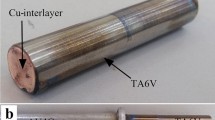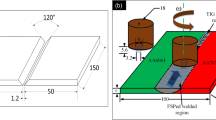Abstract
Effects of processing parameters on the temperature field and axial shortening of linear-friction-welded joint of TC11 and TC17 titanium alloys are investigated by numerical simulation and experimental methods. The 2D model, which is simplified as a rigid body and a deformable body, is built on the basis of the LFW principle by ABAQUS/explicit software. LFW experiments are developed to verify the rationality of the model by measuring the temperature field and axial shortening. The results show that, during the friction phase, the temperature rises linearly with increasing friction time and decreasing axial shortening, heating rates slightly increase with increasing friction pressures and decrease with increasing amplitudes, and cooling rates increase with increasing friction pressures and amplitudes in the forging phase. The unilateral axial shortenings of TC11 and TC17 increase nearly linearly with increasing power input. The appropriate power input for the welded joint is measured to be in the range of 2.4 × 107 to 3.36 × 107 W/m2 based on the tensile properties and fracture morphologies. The corresponding microstructure of the welded zone (WZ) consists of a large number of fine lath martensites α′ on the TC11 side and coarsened β phases with a small amount of precipitations on the TC17 side.
















Similar content being viewed by others
References
H.J. Liu and L. Zhou, Microstructural Zones and Tensile Characteristics of Friction Stir Welded Joint of TC4 Titanium Alloy, Trans. Nonferrous Met. Soc., 2010, 20, p 1873–1878
I. Bantounas, D. Dye, and T.C. Lindley, The Effect of Grain Orientation on Fracture Morphology During High-Cycle Fatigue of Ti-6Al-4V, Acta Mater., 2009, 57, p 3584–3595
N. Saresh, M.G. Pillai, and J. Mathew, Investigations into the Effects of Electron Beam Welding on Thick Ti-6Al-4V Titanium Alloy, J. Mater. Process. Technol., 2007, 192-193, p 83–88
A.R. Mcandrew, P.A. Colegrove, C. Buhr, B.C.D. Flipo, and A. Vairis, A Literature Review of Ti-6Al-4V Linear Friction Welding, Prog. Mater. Sci., 2018, 92, p 225–257
Z.Y. Ma, Friction Stir Processing Technology: A Review, Metall. Mater. Trans. A, 2008, 39A, p 642–658
W.Y. Li, A. Vairis, M. Preuss, and T.J. Ma, Linear and Rotary Friction Welding Review, Int. Mater. Rev., 2016, 61, p 71–100
T.J. Ma, L.F. Tang, W.Y. Li, Y. Zhang, Y. Xiao, and A. Vairis, Linear Friction Welding of a Solid-Solution Strengthened Ni-Based Superalloy: Microstructure Evolution and Mechanical Properties Studies, J. Manuf. Process., 2018, 34, p 442–450
P. Zhao and L. Fu, Strain Hardening Behavior of Linear Friction Welded Joints Between TC11 and TC17 Dissimilar Titanium Alloys, Mater. Sci. Eng. A Struct., 2015, 621, p 149–156
P. Zhao, L. Fu, and H. Chen, Low Cycle Fatigue Properties of Linear Friction Welded Joint of TC11 and TC17 Titanium Alloys, J. Alloys Compd., 2016, 675, p 248–256
R. Turner, J.C. Gebelin, R.M. Ward, and R.C. Reed, Linear Friction Welding of Ti-6Al-4V: Modelling and Validation, Acta Mater., 2011, 59, p 3792–3803
E.A. Starke Jr., and J.C. Williams, Progress in Structural Materials for Aerospace Systems, Acta Mater., 2003, 51, p 5775–5799
J. Tao, T.C. Zhang, P.T. Liu, J. Li, and Y. Mang, Numerical Computation of a Linear Friction Welding Process, Mater. Sci. Forum, 2008, 575-578, p 811–815
A. Vairis and M. Frost, Modelling the Linear Friction Welding of Titanium Blocks, Mater. Sci. Eng. A Struct., 2000, 292, p 8–17
A.R. Mcandrew, P.A. Colegrove, A.C. Addison, B.C.D. Flipo, and M.J. Russell, Modelling the Influence of the Process Inputs on the Removal of Surface Contaminants from Ti-6Al-4V Linear Friction Welds, Mater. Des., 2015, 66, p 183–195
E. Ceretti, L. Fratini, C. Giardini, and S.D. La, Numerical Modelling of the Linear Friction Welding Process, Int. J. Mater. Form., 2010, 3, p 1015–1018
W.Y. Li, S.X. Shi, F.F. Wang, T.J. Ma, and A. Vairis, Heat Reflux in Flash and Its Effect on Joint Temperature History During Linear Friction Welding of Steel, Int. J. Therm. Sci., 2013, 67, p 192–199
J. Sorina-muller, M. Rettenmayr, D. Schneefeld, O. Roder, and W. Fried, FEM Simulation of the Linear Friction Welding of Titanium Alloys, Comput. Mater. Sci., 2010, 48, p 749–758
P. Wanjara and M. Jahazi, Linear Friction Welding of Ti-6Al-4V: Processing, Microstructure, and Mechanical-Property Inter-relationships, Metall. Mater. Trans. A, 2005, 36, p 2149–2164
A. Vairis and M. Frost, High Frequency Linear Friction Welding of a Titanium Alloy, Wear, 1998, 217, p 117–131
P.K. Zhao, L. Fu, and D.C. Zhong, Numerical Simulation of Transient Temperature and Axial Deformation During Linear Friction Welding Between TC11 and TC17 Titanium Alloys, Comput. Mater. Sci., 2014, 92, p 325–333
A.B. Li, L.J. Huang, Q.Y. Meng, L. Geng, and X.P. Cui, Hot working of Ti-6Al-3Mo-2Zr-0.3Si alloy with lamellar alpha plus beta starting structure using processing map, Mater. Des., 2009, 30, p 1625–1631
B. Lang, T.C. Zhang, X.H. Li, and D.L. Guo, Microstructural Evolution of a TC11 Titanium Alloy During Linear Friction Welding, J. Mater. Sci., 2010, 45, p 6218–6224
S.Q. Wang, J.H. Liu, and D.L. Chen, Effect of Strain Rate and Temperature on Strain Hardening Behavior of a Dissimilar Joint Between Ti-6Al-4V and Ti17 Alloys, Mater. Des., 2014, 56, p 174–184
E. Eisenbarth, D. Velten, M. Müller, R. Thull, and J. Breme, Biocompatibility of β-Stabilizing Elements of Titanium Alloys, Biomaterials, 2004, 25, p 5705–5713
Y.X. Tong, B. Guo, Y.F. Zheng, C.Y. Chung, and L.W. Ma, Effects of Sn and Zr on the Microstructure and Mechanical Properties of Ti-Ta-Based Shape Memory Alloys, J. Mater. Eng. Perform., 2011, 20, p 762–766
S.Q. Wang, J.H. Liu, Z.X. Lu, and D.L. Chen, Cyclic Deformation of Dissimilar Welded Joints Between Ti-6Al-4V and Ti17 Alloys: Effect of Strain Ratio, Mater. Sci. Eng. A Struct., 2014, 598, p 122–134
W.Y. Li, T.J. Ma, and J.L. Li, Numerical Simulation of Linear Friction Welding of Titanium Alloy: Effects of Processing Parameters, Mater. Des., 2010, 31, p 1497–1507
Acknowledgments
This work is supported by China Postdoctoral Science Foundation (No. 2017M613172), Natural Science Foundation of Shaanxi Provincial Department of Education (No. 17JK0562), and Natural Science Basic Research Plan in Shaanxi Province of China (No. 2016JM5074). The computations are supported by Central for High Performance Computing of Northwestern Polytechnical University, China. We thank LetPub (www.letpub.com) for its linguistic assistance during the preparation of this manuscript.
Author information
Authors and Affiliations
Corresponding author
Additional information
Publisher's Note
Springer Nature remains neutral with regard to jurisdictional claims in published maps and institutional affiliations.
Rights and permissions
About this article
Cite this article
Zhao, P., Fu, L. Numerical and Experimental Investigation on Power Input during Linear Friction Welding Between TC11 and TC17 Alloys. J. of Materi Eng and Perform 29, 2061–2072 (2020). https://doi.org/10.1007/s11665-020-04745-6
Received:
Revised:
Published:
Issue Date:
DOI: https://doi.org/10.1007/s11665-020-04745-6




